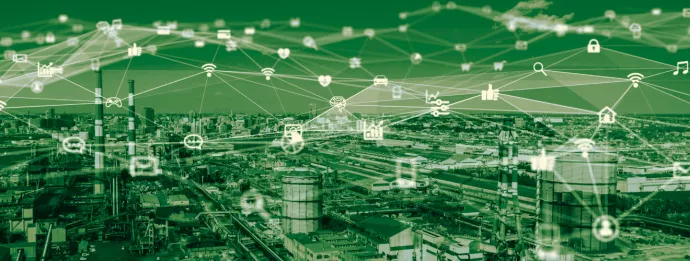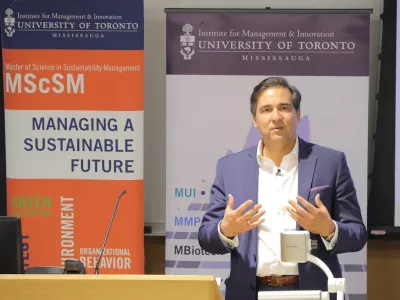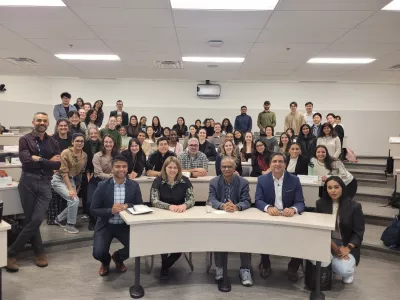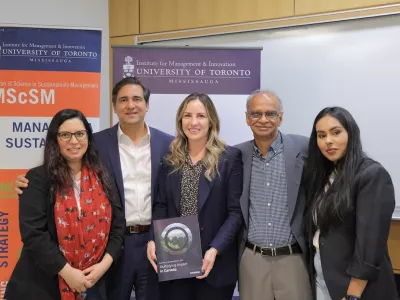
Combining the power of technology and innovation to create benefit for society: Siemens Canada’s President and CEO talks climate change and the industrial metaverse.
“Climate change is one of the biggest challenges we face in humanity”, said Faisal Kazi, President & CEO of Siemens Canada, speaking to a room packed with graduate students and campus leaders, as part of the MScSM Program’s Speaker Series. Kazi believes the industrial metaverse is a technological evolution that will enable rapid and effective solutions to the biggest challenge we face globally, including climate change.

On November 2, Kazi visited UTM to speak about Siemens Canada’s core goals in creating benefit to society, and their role in encouraging progress toward the Industrial Metaverse. In Kazi’s view, the Industrial Metaverse is a critical tool in combatting the catastrophic outcomes of humanity’s current sustainability trajectory, on which we are using, on average, our planet’s resources at a rate of 1.7 times higher than it can regenerate.
The Metaverse, announced by Facebook in 2021, was touted as an immersive, fantasy environment, primarily related to the gaming industry. The concept, however, has not become what early adopters thought it might. Kazi, however, sees the industrial metaverse – a much more specialized, purposeful innovation - as a tremendously practical and useful tool.
“We have gone through different shifts”, he says, “and we’re already in the era of Digital Twins”. Digital Twins – the idea of creating a digital copy of a physical asset – is one step before the industrial metaverse, according to Kazi. As an example, an automotive manufacturer can produce a vehicle in a virtual environment, allowing them to test all elements (like the brakes), before building a real, tangible vehicle. Siemens Formula 1 Redbull Car, for instance, has a digital twin. Between races, engineers make up to 1000 changes per week to the car; first in the digital twin, and then, once assured of success, on the real vehicle. “It’s going well, so far!”, Kazi says with a smile.

As another example, Kazi spoke about the impact of digital twin systems on healthcare and community, for instance in prosthetics. “57 million people have limb loss”, he explained, and to reduce the staggering cost to patients, digital twin technology can be used to create customized, artificial limbs, at a 90% lower cost. In terms of climate change, such technology is being deployed rapidly in the industrial sector – opening the doors (both digital and physical) to the industrial metaverse. Siemens designed a fully operating factory in China in a virtual environment. When built, the factory was 20% more productive and 40% more flexible than similar factories around the world, resulting in an immediate environmental impact.
There are some key enabling technologies involved; “a convergence”, says Kazi, including the internet of things, cloud computing, AI, machine learning, virtual and augmented reality, networks, and blockchain. Together, these systems can create the industrial metaverse, to “solve real-life problems in a virtual world using technology”.
Take, for instance, battery plants, which use advanced robots in manufacturing plans, with specialized grippers (like arms) that pick up and move heavy batteries. Moving in many directions, this system has inertia, and weight. Using a generative AI model, Siemens asked the system to create a new model that could achieve the same outcomes – but better. The result was a far simpler robot, with 80% less weight, and a 90% CO2 reduction over its lifetime. When it comes to the batteries themselves, Siemens is also using simulated scenarios to map out processes and battery mixes to lower their impact, from scrap to usage.
Why, then, is there not wider adoption of the industrial metaverse yet?
“We have a lack of connectivity”, says Kazi. Siemens is working with a diverse range of partners around the world to tackle this. “The Industrial Metaverse will not be built by one company, but rather a collaboration of many”, he says.
On the subject of leadership, rapid transformational change, and impact on workers, Kazi had a clear message for leaders: if an industry is disrupted, help people to retrain. “This is our core responsibility”, he says, “are you taking the people who are disrupted with you?”.
When it comes to sustainability, says Kazi, “we have to change our habits”. While the industrial metaverse will go a long way toward making our infrastructure more sustainable, people themselves need to be focused on their impact, both in terms of sustainability, and their contributions to the world. “When you create value,” he says, “everything will come”.
Siemens Canada & The MScSM Program Partnership

The Master of Science in Sustainability Management Program and Siemens Canada work together to foster experiential learning opportunities in sustainability. MScSM Alumnus Amy Geisberger (MScSM ‘18) joined Siemens Canada as Sustainability Manager in July 2022. In the summer of 2023, interns Anna Bremermann and Lina Contreras joined the Siemens team. Anna, as Project Coordinator Student, worked with CEO Faisal Kazi, focusing on renewable energy, net-zero and decarbonization. Lina, as Sustainability Intern, worked on Siemens’ Multiplying Impact in Canada Report.
